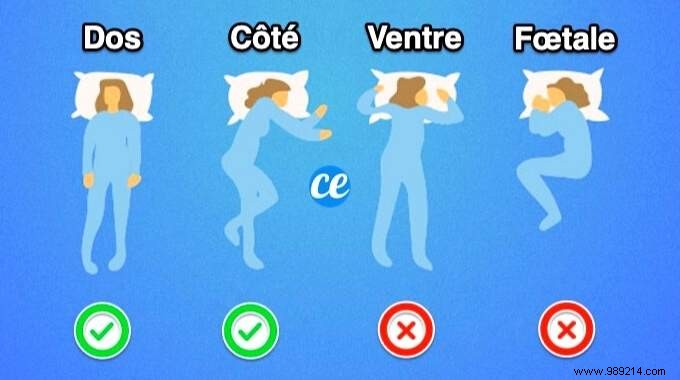
When you go to bed, you don't really think about the way we lie down.
The concern is that our sleeping position greatly influences our health.
Indeed, medical specialists have shown that our position is a determining factor many sleep disorders, and health in general.
Depending on whether you sleep on your stomach, back or side, this impacts snoring, sleep apnea, and neck and back pain.
So, get ready to discover the best position to sleep and avoid back pain ? Watch:

Click here to easily print this guide in PDF.
According to scientific studies, the majority of people prefer to sleep on their side .
They are closely followed by those who sleep on their backs .
And finally, a very small percentage of people sleep on their stomachs .

Everyone knows that sleep plays an important role in health. Click here to discover all the benefits of sleep.
But did you know that your sleeping position can also affect the quality of your sleep, and even cause certain health problems?
So what's the best (and worst) sleeping position?

Do you like sleeping on your stomach? You are not alone, but know that this is an infrequent position for sleeping.
In fact, only 7% of adults sleep on their stomachs.
Sleeping on your stomach helps to reduce the sound of snoring, a considerable advantage.
Yet sleep experts advise against sleeping on your stomach.
When your head rests on a pillow, it is elevated.
This makes maintaining and proper spinal alignment particularly difficult.
Thus, sleeping on your stomach creates tension in the back and neck.
And because the trunk is the heaviest part of the body, the back ends up bent the full length of the spine.
Over time, this can lead to pain and nerve problems.
Some people may experience numbness or a tingling sensation in the limbs.
And it's not over...
To sleep on your stomach, you have to turn your head to one side, which can affect blood circulation and constrict the airways.
If you can't sleep other than on your stomach, at least try to make some improvements to this position.
For example, to keep your neck straight, just put your forehead on the lower edge of your pillow.
This will help keep the spine in a more or less neutral position.
It also helps to relax the airways and breathe more easily.
You can also slide a thin pillow under the pelvis, which helps relieve tension in the lower back.
Sleeping on your side can be comfortable, but this position is not recommended for sleeping.
It recalls the fetal position, that is to say the original position in the womb of the mother.
The problem is that if you sleep in the fetal position, the spine is too curved .
As a result, it can cause twisting and pain in the neck and back.
In addition, sleeping in a completely curled up position can interfere with the diaphragm and therefore slow breathing.
This is the second most common sleeping position.
Sleeping flat on your back is a natural position, which allows good alignment of the neck with the spine.
This is an ideal position to avoid pain that we tend to feel with other positions, including neck, shoulder and back pain.
In addition, sleeping on your back and raising your head slightly with a pillow can reduce the problems of acid reflux and heartburn.
But beware, there is a downside. This position promotes snoring and sleep apnea.
Indeed, during sleep, the tongue and throat muscles relax.
And if you sleep on your back, the soft tissues of the throat tend to sag towards the back of the throat, blocking the airways.
If you suffer from sleep apnea, ask your doctor for advice on the best way to change your sleep habits.
Maybe you sleep on your back and suffer from lower back pain?
The solution is to put a small pillow under the neck and a medium-sized pillow under the knees, to better respect the natural curvature of the spine.
This will allow you to relieve pain and reduce twists in the lower back.
For most people, this is the most comfortable sleeping position.
And for good reason:doctors and sleep specialists recommend sleeping on your side, as it brings many benefits.
With a mattress that is neither too soft nor too hard, this position allows you to maintain the natural curves of the spine .
Therefore, sleeping on your side helps to avoid excessive pain and twisting in the neck, back and shoulders.
It is also the best position for people who snore loudly or suffer from sleep apnea.
Indeed, if you sleep on your side, the airways remain unblocked, even when the muscles of the body relax.
Studies have shown that sleeping on your side helps reduce the frequency of sleep apnea, and this promotes more restful and better quality sleep.
This is also the recommended position for people who suffer from arthritis, acid reflux and neck and back pain.
In pregnant women, it is advisable to sleep on the left side , especially during the second and third trimesters.
Sleeping on the left side improves blood flow to the placenta and kidney function, which helps reduce swelling in the legs and feet.
Know that sleeping on your side is even healthier when the torso and legs are kept more or less straight.
Indeed, in this position, the spine is not only stretched, but it is also well aligned.
To keep your head and neck straight when sleeping on your back, it is also advisable to use a firm, medium-thickness pillow.
Sleep specialists advise using an orthopedic pillow, like this one.
To relieve pressure in the lower back, it is also advisable to put a cushion between the knees and the thighs.
Thanks to this position, the correct distance between the hips is well maintained, and pain in the hips and lower back is thus avoided.
